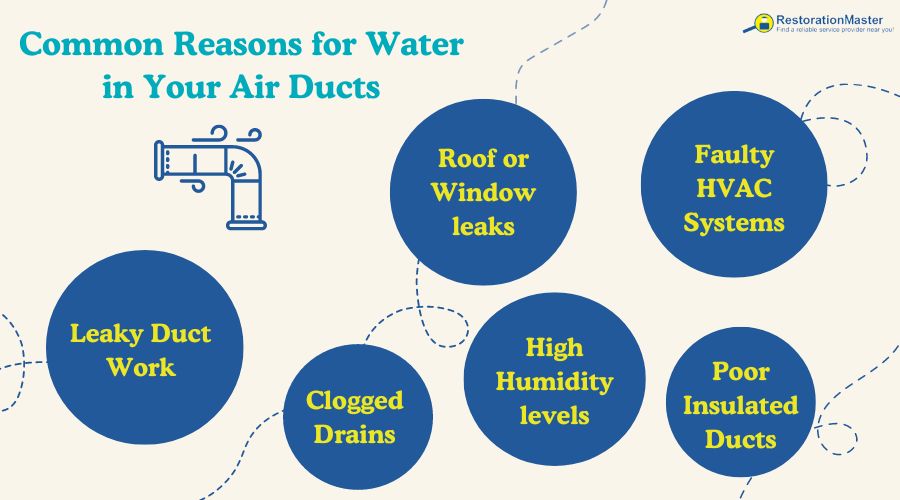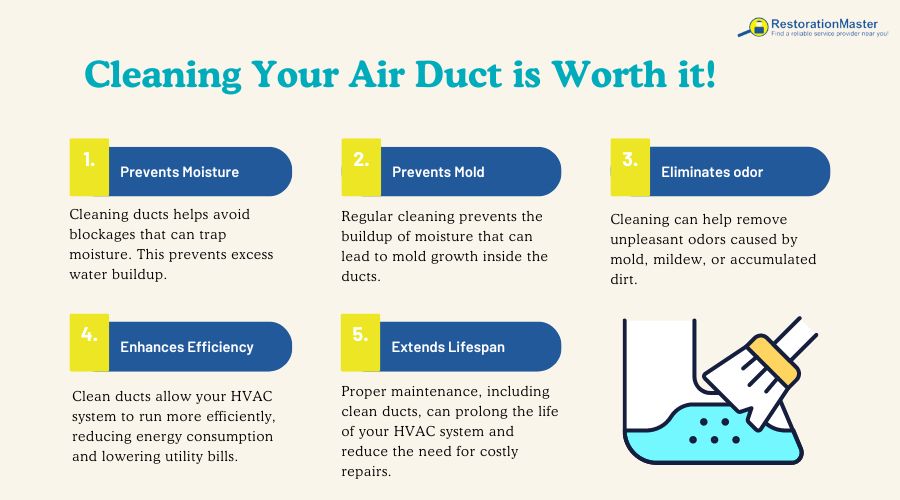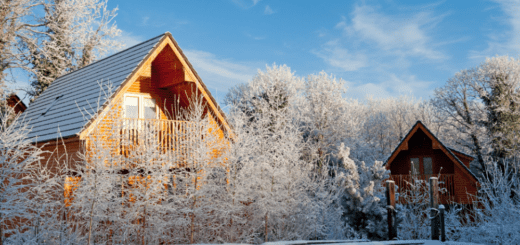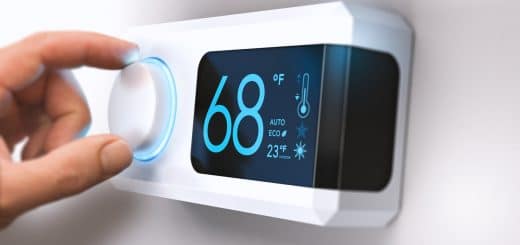How to Get Water Out of Air Ducts
Clean, dry air ducts are instrumental in efficiently moving heated or cooled air throughout a home. The air ducts are linked with a building’s heating, ventilationVentilation is the process of exchanging or circulating air ... More and air conditioning (HVAC) system. When water intrudes, it is critical to promptly eliminate the moisture from the air ducts.
How Does Water Get into the Air Ducts?
Moisture inside the air ducts is a common occurrence. A leaky roof or ruptured pipes can easily transfer water into the air ducts. The ductwork installed on the roof often lacks a watertight seal, which allows a pathway through the seams and into the interior ducts and vents.

Moisture in air ducts can also be caused by the accumulation of condensation near the cooling coils of air conditioning systems. In such cases, condensation is expected. The air temperature inside the HVAC is cooler than the surrounding air, leading to a buildup of condensation.
Newer, more advanced HVAC systems are fitted with mechanisms that extract excess moisture to prevent the possible destruction of the ductwork. Issues with condensation, however, can still arise due to incorrect HVAC installation, improper air duct service and malfunctioning systems.
FloodingFlooding is the overflow or accumulation of water in areas t... More, too, can cause moisture to build up inside the air ducts. Across the US, floodingFlooding is the overflow or accumulation of water in areas t... More is a known threat during every month of the year. Flash floods, river floods, ice jams, snowmelt and dam breaks are causes of floodingFlooding is the overflow or accumulation of water in areas t... More. Rainwater is one of the most common causes of floods.
When HVAC systems sit at ground level, the equipment is exposed to rising floodwaters. The coils, fans and chambers become dirty when infiltrated with floodwater. To re-use the system safely, the many parts and cavities require a professional air duct cleaning or replacement by remediation experts.
What are the Dangers of Moisture Buildup?
The number one concern of water inside the air ducts is moldMold is a type of fungus that grows in damp or humid conditi... More growth. Under ideal conditions, moldMold is a type of fungus that grows in damp or humid conditi... More sporesSpores are microscopic reproductive units of fungi or mold t... More can flourish within 48 hours. MoldMold is a type of fungus that grows in damp or humid conditi... More needs only an organic food source, moisture and warm temperatures to grow. The air ducts provide all the necessary sustenance for a moldMold is a type of fungus that grows in damp or humid conditi... More outbreak.
Mold spores colonizing the air ducts are rapidly blown throughout the home via the vents. The sporesSpores are microscopic reproductive units of fungi or mold t... More become airborne, landing on furniture, carpeting and clothing—which exacerbates the indoor moldMold is a type of fungus that grows in damp or humid conditi... More problem. Indoor air qualityIndoor air quality (IAQ) refers to the condition of the air ... More is also reduced. Breathing moldMold is a type of fungus that grows in damp or humid conditi... More can trigger health problems.
Aside from moldMold is a type of fungus that grows in damp or humid conditi... More growth, moisture inside the air ducts can reduce the insulation’s R-value. Over time, the water compresses the insulationInsulation is a material used in buildings to reduce the tra... More, causing it to become less efficient. As the insulation’s R-value decreases, homeowners can expect higher utility bills and energy loss.
Lastly, water damage to the walls, ceilings and roof can result from moisture inside the air ducts. Excess moisture can gradually be a cause of corrosion or decay in these materials. If left unaddressed for prolonged periods, the structural ruin can compromise the integrity of the building.
What Methods Reduce Moisture Buildup?
Long-term solutions attack the source of the moisture problem within the air ducts. A leaky roof or water pipe, for instance, should be repaired immediately. Turn down the humidifier if it is cranked up too high. Essentially, look for sources of moisture and fix them quickly.
A tool to help homeowners gauge the level of humidityHumidity is the amount of moisture or water vapor present in... More inside the home is the hygrometer. The hygrometer uses one wet bulb and one dry bulb as thermometers. The relative humidityRelative humidity (RH) is the percentage of moisture in the ... More is determined by comparing the two thermometers. Abnormal levels alert homeowners of a problem.
If the furnace and clothes dryer vents are free of leaks, and all other systems are in good working condition, the next step is to run a dehumidifierA dehumidifier is a device that removes excess moisture from... More near areas where condensation collects. As the dehumidifierA dehumidifier is a device that removes excess moisture from... More draws out moisture, condensation decreases inside the ducts.
Sealing off unused A/C ducts also keeps out unwanted moisture. Simply closing the supply and return vents is ineffective, since the dampers are not airtight. Instead, cut foam board insulationInsulation is a material used in buildings to reduce the tra... More into the size of the ducts and place them inside. Or, tape plastic sheeting over the ducts.
Consider adding insulationInsulation is a material used in buildings to reduce the tra... More to an uninsulated attic. InsulationInsulation is a material used in buildings to reduce the tra... More prevents the development of condensation on cold ductwork. Standard duct insulationInsulation is a material used in buildings to reduce the tra... More is enough to keep the air ducts from cooling and forming condensation. Circulate warm air through unused ducts as another tactic to prevent condensation.
Water inside the air ducts is a hazardous problem, but can be resolved by consulting a professional air duct cleaning company. Technicians use HEPA air scrubbers and hydroxyl or ozone generators to scrub the air, removing bacteria, moldMold is a type of fungus that grows in damp or humid conditi... More sporesSpores are microscopic reproductive units of fungi or mold t... More and lingering odors.
Get a Professional Air Duct Cleaning
The professional duct cleaner’s air purifying process prevents the HVAC from recirculating air contaminated with moldMold is a type of fungus that grows in damp or humid conditi... More sporesSpores are microscopic reproductive units of fungi or mold t... More through the ductwork and into the home. The technique ensures that the indoor air qualityIndoor air quality (IAQ) refers to the condition of the air ... More is high and breathable for the home’s occupants.
Wet air ducts are a risk to your home’s structural safety and indoor air qualityIndoor air quality (IAQ) refers to the condition of the air ... More. When you discover dampness in the air ducts, either due to a recent flood, condensation or any of the above-mentioned causes, it is important to call a restorationRestoration is the process of returning a property to its pr... More professional.

Water Damage Restoration
A team of IICRC-certified water damage restoration technicians is equipped to handle any level of water damage to your home or business. They work quickly to prevent the spread of water damage to other parts of the residential or commercial property.
Their advanced processes include using water extraction equipment to remove excess water. Trained specialists set up powerful dehumidifiers and dryingDrying is the process of removing moisture from materials, s... More equipment to draw out moisture absorbed in furniture, floors and building materials. They will also clean and restore the affected area.
After the water damage restoration process, they will work with your insurance company during the claims process so you can focus on other matters. Finally, you can look forward to clean and dry air ducts free of moldMold is a type of fungus that grows in damp or humid conditi... More.












